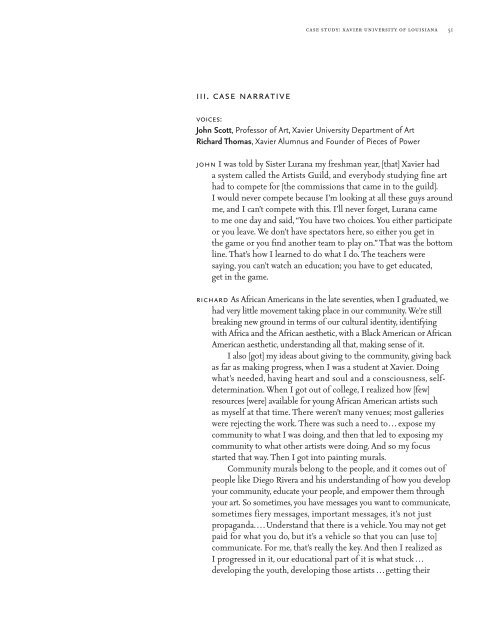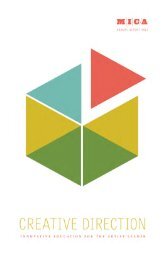art/vision/voice - Maryland Institute College of Art
art/vision/voice - Maryland Institute College of Art
art/vision/voice - Maryland Institute College of Art
Create successful ePaper yourself
Turn your PDF publications into a flip-book with our unique Google optimized e-Paper software.
iii. case narrative<br />
case study: xavier university <strong>of</strong> louisiana 51<br />
<strong>voice</strong>s:<br />
John Scott, Pr<strong>of</strong>essor <strong>of</strong> <strong>Art</strong>, Xavier University Dep<strong>art</strong>ment <strong>of</strong> <strong>Art</strong><br />
Richard Thomas, Xavier Alumnus and Founder <strong>of</strong> Pieces <strong>of</strong> Power<br />
john I was told by Sister Lurana my freshman year, [that] Xavier had<br />
a system called the <strong>Art</strong>ists Guild, and everybody studying fine <strong>art</strong><br />
had to compete for [the commissions that came in to the guild].<br />
I would never compete because I’m looking at all these guys around<br />
me, and I can’t compete with this. I’ll never forget, Lurana came<br />
to me one day and said, “You have two choices. You either p<strong>art</strong>icipate<br />
or you leave. We don’t have spectators here, so either you get in<br />
the game or you find another team to play on.” That was the bottom<br />
line. That’s how I learned to do what I do. The teachers were<br />
saying, you can’t watch an education; you have to get educated,<br />
get in the game.<br />
richard As African Americans in the late seventies, when I graduated, we<br />
had very little movement taking place in our community. We’re still<br />
breaking new ground in terms <strong>of</strong> our cultural identity, identifying<br />
with Africa and the African aesthetic, with a Black American or African<br />
American aesthetic, understanding all that, making sense <strong>of</strong> it.<br />
I also [got] my ideas about giving to the community, giving back<br />
as far as making progress, when I was a student at Xavier. Doing<br />
what’s needed, having he<strong>art</strong> and soul and a consciousness, selfdetermination.<br />
When I got out <strong>of</strong> college, I realized how [few]<br />
resources [were] available for young African American <strong>art</strong>ists such<br />
as myself at that time. There weren’t many venues; most galleries<br />
were rejecting the work. There was such a need to. . . expose my<br />
community to what I was doing, and then that led to exposing my<br />
community to what other <strong>art</strong>ists were doing. And so my focus<br />
st<strong>art</strong>ed that way. Then I got into painting murals.<br />
Community murals belong to the people, and it comes out <strong>of</strong><br />
people like Diego Rivera and his understanding <strong>of</strong> how you develop<br />
your community, educate your people, and empower them through<br />
your <strong>art</strong>. So sometimes, you have messages you want to communicate,<br />
sometimes fiery messages, important messages, it’s not just<br />
propaganda. . . . Understand that there is a vehicle. You may not get<br />
paid for what you do, but it’s a vehicle so that you can [use to]<br />
communicate. For me, that’s really the key. And then I realized as<br />
I progressed in it, our educational p<strong>art</strong> <strong>of</strong> it is what stuck . . .<br />
developing the youth, developing those <strong>art</strong>ists . . . getting their
















